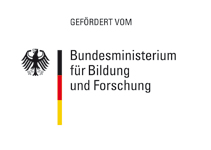A visual essay by Milena Koch
1. Introduction
Transgender individuals in India are commonly known as hijras. Hijras are usually born males who assume a neither-male-nor-female gender role by adopting women’s behavior and clothes. Furthermore, most of them undergo castration that supposedly give them the power to both bless and curse male newborns and newly-weds with fertility and infertility. They identify themselves with several gods from Hindu mythology to legitimize their role and practices in daily life. Although hijras are attributed with ritual power, they lack society’s acceptance due to their “abnormal” gender which does not fit into the binary characteristics. Further, they became one of the most disempowered groups throughout India and other South Asian countries. Thus, sex work and begging for alms became their source of income. Due to those reasons, hijras face various types of discrimination, exclusion and violence in urban public spaces.
Because discourses on public spaces seem to largely focus on gender-based-issues of men or woman, this essay draws attention to issues of the group of hijras, a male-to-female transgender community. Of course, hijras also face gender-based violence in more private spaces like the family as well as in rural or semi-urban landscapes. However, this work only focuses on violence against hijras in public spaces in urban India. For this purpose, the essay initially provides information about the gender identity and changes in social roles of hijras that today have resulted in discrimination. This is followed by the investigation of hijras private life in self-organized communities that provide security and further, how community life provides an opportunity to build alternative forms of relationships. Finally, the paper addresses the question: Why do particularly hijras face discrimination in public spaces? In order to answer the question, the paper investigates various forms of discrimination, exclusion and violence in public spaces with a particular focus on health care institutions and harassment as well as abuse by the police.
The essay draws on available literature and case studies of hijras in urban India. After various campaigns and protests by transgender activists, the “third gender”-category has achieved full legal recognition in April 2014. Due to limited published studies, long-term changes for transgender individuals after state recognition are not considered in here.
2. Hijras: Neither male nor female
Gender conceptions existed in all societies before present time and furthermore, were divided into two categories: male and female. In contrast to the biological sex, both identities are socially constructed. They distinguished by forms of expression like body appearance, gestures or behavior in public that constitute social ideals of masculinity and femininity (Srivastava 2012: 18). While most people identify themselves to either maleness or femaleness, some individuals do not feel that sense of belonging to their biological sex. While a person’s biological sex is determined by birth due to male or female genitals, “gender identity is the private experience of gender role, that sameness, unity, and persistence of one’s individuality as male, female, or androgynous, especially as experienced in self-awareness and behavior” (Nanda 1999: 114). The group of people who do not identify themselves as males or females are often termed as “third sex”, “other gender”, “third gender”, “alternative gender” or “transgender”. Those terms designate gender non-conforming individuals who may identify their sexual orientation as lesbian, gay, heterosexual, bisexual, asexual and other such identities. Symbolically, “transgender” represents boundary-crossing people who view themselves as neither male nor female (Prabhughate et al. 2012: 174-175).
2.1 Social roles and gender identity
The role of hijras as transgender individuals is deeply rooted in Indian culture and mythology (ibid.: 175). Individuals belonging to hijra communities are born males or rarely born hermaphrodites (born with both male and female sex characteristics). The hijra role particularly attracts individuals who have different cross-gender identities, personality constellations, behavior and attributes (Nanda 1999: 20). But above all, most hijras decide to join the transgender community in their youth for reasons such as the escape from poverty, to completely express their feminine gender identity, due to bad treatment by their family of origin for female attitude or after a time period of homosexual prostitution (ibid.: 116). Therefore it may be assumed that there is not one but a series of early life events and effects which are affecting somebody in formally joining transsexual communities by adopting female behavior and clothing, taking female names and by undergoing emasculation operations or surgical removal of the male genitals.
Hijras believe that emasculation is the source for their ritual power and the religious obligation for their social identity (ibid.: 15, 24). In mythical stories, castration is necessary in order to change into third gender. “Through the bleeding, maleness flows out, femaleness flows in; mixture results” (Cohen 1995: 285). Further, in Hindu mythology, impotence creates generative power through the ascetic practices of sexual abstinence in terms of emasculation (Nanda 1999: 29). In general, Hinduism accommodates categories of transgenderism and furthermore, gives them a particular powerful importance. References to a third sex, androgynies or individuals who have undergone sex changes can be found throughout various texts of Indian mythology (ibid.: 20). Not only examples and stories of humans but also deities are detectable in ancient Hindu texts (e.g. the Vedas, Kamasutra or Mahabharata). Therefore, god Shiva (in the popular form of Ardhanareshwara) is one of the most important sexually ambivalent deities, who incorporates male and female characteristics and thus, is referred to as “half-woman god” (García-Arroyo 2010: 26). Shiva is paradoxically portrayed as both ascetic and erotic and thus, hijras use his iconographic image to articulate their affinity towards Shiva and further, to receive respect and to legitimize their role and practices in social life (Reddy 2005: 87-89).
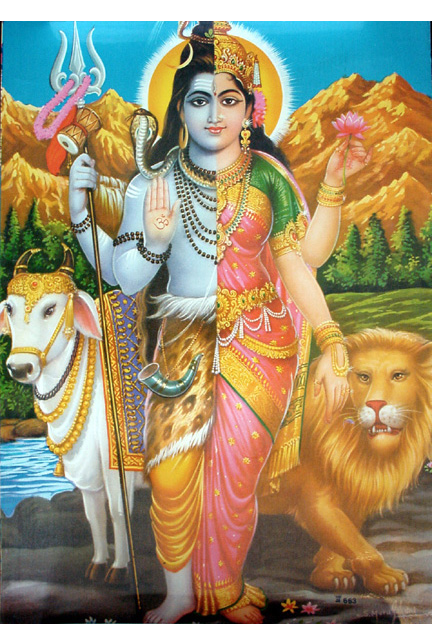
God Shiva in the form of Ardhanareshwara, portrayed as half male and half female.
Through impotence and the inability to reproduce, hijras can transform their liability into generative power that enables them to act as ritual performers in blessing but also cursing newborn infants and newlyweds with fertility and prosperity (Nanda 1999: 30). Hijras also identify with Arjun, a hero of the Hindu epic Mahabharata who assumed a eunuch-transvestite identity and performed songs and dances at weddings and childbirths (Nanda 2014: 31). Besides their affinity towards Shiva and Arjun, all hijras – whether Hindu or Muslim – worship Bahucchara Mata who is particularly associated with transgenderism. From their identification with the Hindu goddess, they also derive procreative power (Reddy 2005: 97).
During ancient times and until the 19th century, hijras received respect, public acceptance and payments from their ritual performance (badhai) that were central to their social role (ibid.: 13). Honored for undergoing castration and thus, well-established in the culture of eunuchs, hijras held sanctioned positions in royal courts (e.g. serving as advisers or guarding concubines and harems) (Peoples’ Union for Civil Liberties-Karnataka 2003: 17). But with colonialism and different Christian moral values, the British colonialists passed a law (1871) in classing all persons of male sex who appear to be impotent by emasculation or dressed like women as criminals. According to that, eunuchs and hijras were suspicious in kidnapping children due to their infertility and further, gradually disappeared from public spaces (Hinchy 2014: 276).
2.2 Private life in communities
Since hijras have been ostracized, they organize themselves in social communities with local, regional and national structures in rural, semi-urban or urban landscapes throughout India and other South Asian countries (e.g. Pakistan or Bangladesh). Hijra community members can be Hindu, Muslim or Christian and moreover, belong to all social classes and castes (although people from lower or untouchable castes are predominant). Regardless of religion or caste-like rules, they live in the same households which are significant in transgender social organization and cohesion (Nanda 1999: 41). Hijra communities usually contain between five to 20 members with one head of the household. Most communities are located in a particular area of town to separate transgender individuals from the civil society and to ensure protection. Every member supports the community with money or by performing domestic tasks. Among their local, regional and national communities they established kinship networks, among other things, for their social reproduction (Nanda 2014: 35-36). Those households are organized into one of seven nationwide “houses”. The most important relationship among hijra communities is between the spiritual mentor (guru) and disciples (chelas). The guru initiates new members into the community through a specific ritual. From that moment on, the new member is related to hijras all over India by fictive kinship. Further, the guru-chela relationship “replicates the ideals of an extended family is ideally a lifelong bond of reciprocity: The guru is obligated to ‘take care of’ the chela in return for the chela’s loyality, obedience, and a fixed percentage of her income” (ibid.: 36).
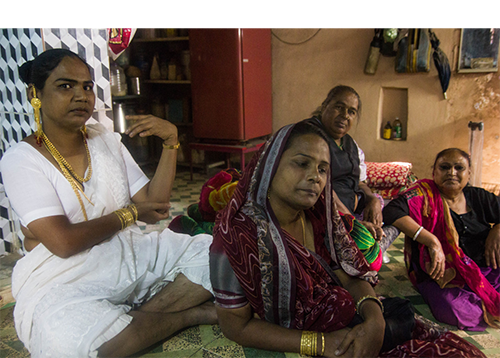
Hijras live together in self-organized communities and establish family-like relationships to each other.
Although the hierarchically guru-chela relationship is the necessary prerequisite bond for kinship within the community, hijras even establish relationships to other hijras in considering themselves as “daughters” of one “mother”, “sisters”, “aunts” or “grandmothers” and sometimes in adopting unwanted or orphaned children. Thus, community membership strengthens the group by providing protection through occurring as cohesive group entity and loyalty. Pierre Bourdieu (1977) defined this close relationship among each other as “practical kinship” (Reddy 2005: 165). Furthermore, according to the anthropologist Serena Nanda (2014), hijras can have long-term sexual, economically and romantic relationships with one man who is referred to as “husband”. Having a husband who provides financial support in exchange for sexual relations is the preferred alternative for hijras who otherwise, often have to earn their living through prostitution. In spite of their ideal roles as ascetics, marriage is a main source of prestige and religious obligation for Indian women and thus, having a husband is important for hijras self-esteem (Nanda 2014: 34-35). Nonetheless, hijras who engage with husbands never break their kinship ties with their community (Reddy 2005: 169). All this points to the fact that hijra communities provide transgender individuals with the possibility of an alternative relationship by a joint household. Thereby, living in hijra communities offer people the change to strengthen their transsexual identity besides of normatively defined families and conservative family ideology in India (Drucker 2015: 341-342).
3. Public appearance and perception of hijras in public places
Besides their private life in hijra communities that provide social organization, community affiliation and safety, transgender individuals often experience gender-based social rejection like discrimination, violence and exclusion in public spaces. According to the anthropologist Srivastava (2012), spaces have a dual identity. Public spaces such as streets, parks, marketplaces, offices, shopping malls, schools or universities often represent male space. In contrast to, the home as private space is represented by females. While males have the privilege to enter and form public spaces as domains of action, women are often excluded by taking care of the domestic sphere (Srivastava 2012: 21-31). The division of public and private spaces into male and female leads to the fact, that public spaces are (besides inherently classed) inherently gendered. As a result, women often become targets of gender-based violence, in particular if they appear as single. Furthermore, people of alternative sexualities which represent “difference” and question the status quo – in particular transgender identities with female public appearance – become victims of public discrimination. On the one hand, hijras lack acceptance and recognition to what is considered by society as “normal”. Their promiscuity in public as well as their frequent involvement in sex work makes them targets of violence (Butalia 2012: 4-5). On the other hand, due to their ascetic generative power through ritual performance, mainstream society sometimes treats hijras with respect and fear.
3.1 Hijras as ritual performers
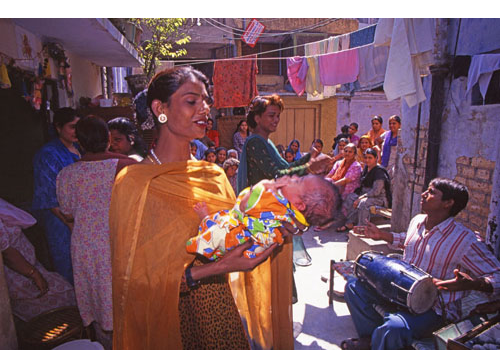
Due to her procreative power, a hijra blesses the male newborn with fertility and prosperity in exchange for money.
The most well-known traditional role of hijras in public is the performance of religious ceremonies at homes when a male child is born. In India, the birth of a son is viewed as one of the major purposes in Hindu life and indeed, a great cause for celebration. At those joyful occasions, hijras bless the child and its family with good luck and fertility in exchange for payment or other goods from the elders of the households (Nanda 1999: 1-3) although hijras usually appear uninvited and show up on their own when they figured out about the newborn (Mal 2015: 109). During their performances, hijras provide entertainment for relatives, friends and neighbors by dancing both traditional but sexual suggestively, playing music instruments (particularly the two-sided dholak-drum) and singing traditional as well as contemporary Indian folk and film songs. Hijras “call these performances badhai, which refers to the traditional gifts of cash and goods that they receive as payment on such occasions” (Nanda 1999: 1). As part of badhai, hijras caricature sexually suggestive feminine behavior and inspect the genitals of the newborn to determine the sex. In addition, their procreative power received from Bahucchara Mata empowers them to bless the infant with the power of creating new life (particularly in procreating sons) to continue the family line.
Another ritual role in public is the hijra performance at marriages. They visit the home of the bride before the wedding and the home of the groom afterwards. In front of a great audience and like the badhai at birth, they bless the couple with fertility and prosperity. Their payment is determined by the size of the group (ibid.: 4). Wherever
“a child is born or a wedding has taken place, the hijras demand their right to perform as they have from time immemorial. These performances are […] the major legitimization of their existence. […] These performances are the most respectable and prestigious way to earn a living within the hijra community and the major source of the hijras’ claim to respect from the larger society” (ibid.: 6).
But as already mentioned, the society’s attitude towards hijras is ambivalent, not least because of the fear that they inspire by cursing somebody for several reasons. Further, societal treatment of the transgender community rests on a combination of fear, mockery and respect. Their inauspicious potential can curse the family with infertility or misfortune when families do not comply with their demands of payment and gifts (ibid.: 6). Another action that both threatens the people as well as a source of shame is the exposition of hijra mutilated genitals by lifting their saris. Exposing their genitals “conveys a potential curse to those who are subjected to the sight” in which they contaminate the person with a loss of reproduction (Reddy 2005: 139).
3.2 Self presentation and earning a living
Apart from hijra recognition in public places through badhai performances they also become visible through external appearance and certain behavior. Their most obvious self-presentation in public life is the way they dress. The hijra presentation of self has been observed since British colonialism. Hijras adopt feminine clothes such as saris or salwar-kameez (Agrawal 1997: 286) but nowadays even Western fashions with padded bras, often accompanied with female jewelry (e.g. nose rings and bangles). They also wear long hair, make-up and shave or pluck out their facial hair so that their face looks smooth like women’s skin (Nanda 1999: 17) but also using estrogen injections, brought illegally from pharmacies (Reddy 2005: 133). Together with their public appearance as women, they adopt female behavior like sitting and standing like women or imitating women’s “swaying walk” (Nanda 1999: 17). Further, in private as well as public hijras use female kinship terms to talk to each other (Agrawal 1997: 286). Although feminine clothes and cultural symbols are an essential characteristic of the hijra, they sometimes use their identity expediently while accessing male appearance and behavior for reasons of employment in male occupations (Nanda 1999: 17). Because hijras sometimes dress and behave like men by threaten women in public to get money, many feminists argue that their self definition as female victims in public is improper (Prabhughate et al. 2012: 178).
Besides their self presentation, hijras are also recognized in public places through behavior patterns such as hand clapping and begging to earn a living apart from their performance at births and weddings. The distinctive hand-clap, more than any other hijra performance, acts as a declaration of identity in public. According to the ethnography on hijras by the anthropologist Gayatri Reddy (2005), hijras want to
“attract attention to themselves as hijras. The clapping served to mark them as hijras in public space, an identity they then levered to their advantage by signaling their difference an disruptive potential, both social/symbolic and physical” (Reddy 2005: 137).
Furthermore, the hand clapping gesture symbolizes the hijras potential power and has the capability to threaten the public by shaming them and to get what they want: more or less voluntarily alms. Begging for alms is a contemporary hijra occupation, particularly carried out in front of shop owners in exchange for their leaving. Hijras also demand alms in public from passers-by or especially in public transportations like trains, where people cannot walk away easily. If somebody does not comply with their demands, hijras often use abusive language and threaten the person with curses of infertility and in exposing their lack of genitals (Reddy 2005: 136-138).
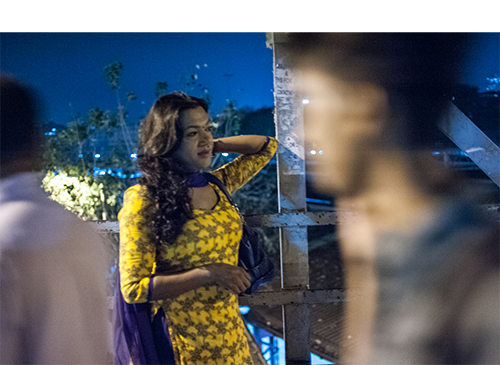
Besides ritual performance and begging, sex work is one of the few chances to earn a living. Kamal tries to attract cliens at Thane station in Mumbai.
Despite their practices of paid performances and begging, sex work is the most profitable option for hijras to earn a living but creates a conflict within the hijra community: On the one hand, prostitution is stigmatized as deviant because of hijras generative power through sexual abstinence. On the other hand, it provides a lucrative income to be prohibited by hijra gurus who furthermore, benefit from the earnings. Hijras engaged in prostitution are mostly managed by a hijra elder or guru of their community and moreover, have no control over their working conditions. All kind of costumers from all castes, professions and social classes have to be served. Hijra prostitutes work in attached houses or flats that are usually located in red-light districts of cities. In smaller towns or rural areas, hijras use their own houses for discrete prostitution. Due to prostitution, hijras receive money but it also provides the opportunity to get into contact with men for long-term sexual relationships. Several researchers who interviewed hijras report that hijra sex workers mostly have oral and anal intercourse with their clients. Sometimes the clients mistake them for women, in other cases costumers prefer them over female prostitutes for reasons of, for example, homosexual preferences or anal sex (although hijras do not identify themselves with homosexuals) (Nanda 1999: 53-54, 64). According to Meera, a hijra guru from Bastipore, men prefer hijra prostitutes rather than women prostitutes for following reasons:
“These men who come to us, they may be married, or unmarried, the father of many children. […] They prefer us to their wives. See, there’s many costumers whose wife has already had three or four children and he still longs for sex, which his lawful wife won’t be able to provide […]. But the hijras can do this [sex] from the back, from behind. These people are attracted to the hijras because they get the satisfaction from the back or a satisfaction from between the thighs” (Nanda 1999: 75) .
Without doubt, the result of prostitution is that society disrespects hijras for sexual practices. As a result, hijras struggle even more as traditionally eunuchs with generative power and thus, become a subject of gender-based discrimination (Patel 2010: 837).
3.3 Gender-based discrimination, exclusion and violence
Though hijras give up their male identity, they give up their privilege and access to experience public spaces as men. Moreover, they appear and behave like women. Through the double oppression of non-conformity to either of the sexes plus accessing public spaces as females, they often face discrimination, exclusion and are more vulnerable to overt, physical and structural violence and harassment in different kinds of public spaces (Prabhughate et al. 2012: 177-178). Society does not accept hijras due to non-conformance with their accepted gender division. Furthermore, hijras also become victims as a result of their mostly lower middle-class background. Thus, gender and class are responsible for making hijra communities to one of the most disempowered groups in India (ibid.: 181). Social attitudes of intolerance to transgender communities become embedded in public places and institutions such as health care and educational institutions or workplaces. This “absence of the ability and space to engage, benefit and contribute to important institutions in the public […], works against establishing the existence of the transgender/hijra identity […]” (ibid.: 177). Those various exclusions also cause bad living conditions (Mal 2015: 110). In many public spaces hijras face harassment in terms of abusive language or become targets of violence like sexual assaults and rape. But in particular, hijras report that they first and foremost face discrimination and violence in health care and due to police harassment.
Castration is one of the most important reasons for hijras to enter healthcare institutions. Sex reassignment surgeries (SRS) are followed by pre and post operative hormonal therapy and psychological counselling. Whereas most developed countries provide such psychological support, in India it is rarely available and thus, SRS is often recognized as unnecessary. This excludes hijras from professional health care. On that score, hijras mostly decide to undergo SRS by traditional doctors under unhygienic conditions that can result into grievous injuries (Prabhughate et al. 2012: 179-180). Furthermore, hijras face discrimination from health personnel because of their association with Sexually Transmitted Diseases and HIV through sex work. Due to prostitution, transgender individuals face a high risk of infecting themselves with HIV, though in fact, the spread of HIV in India is primarily through heterosexual prostitution (Nanda 2014: 34). Stigmatized as being carriers of the virus, hijras feel that health care providers treat them with a lack of personal respect (Mal 2015: 111). This is reflected by doctors who encounter them with transphobia and the avoidance of medical examinations. Discrimination often starts right from the beginning at the registration desk. Hospital staff often addresses hijras by male pronouns and abusive language or make them wait in male waiting areas. This can be followed by placing hijras to sleep on the floor or admitting them to the male ward where they sometimes face harassment by other male patients (Prabhughate et al. 2012: 180). Sometimes, doctors force hijras to show their genitals to medical students without consent. A hijra from Chennai reported:
“That nurse was preparing to give me two shots of penicillin injection on my ‘back’ and I was very afraid of the pain and asked her to inject smoothly. She immediately replied that since I have experienced pleasure through my back now I have to experience pain from the injections in the back. This was in front of other patients and I felt very bad about myself at that time” (Chakrapani et al. 2004: 13).
The other significant issue faced by hijras is the harassment by the police in public spaces. Transsexuals report several incidents of police abuse, including arbitrary arrests and torture of those held in custody. Although mainly men are predominantly in public spaces, hijras also enter those spaces such as local streets, parks, public transportation for begging or to meet other hijras, sexual partners or their husbands. However, entering public places does not provide as much security as their communities do. In India, prostitution in public places is illegal. In addition, due to Supreme Court, gay sex is a criminal offence (Sharma 2014: 2200). Thus, suspected for sex work in public parks and toilets, child-kidnapping to castrate and force them into sex work, traveling ticketless in public transportation and other frequently groundless suspicions that are inflicted largely by the police, hijras become vulnerable to violence (Peoples’ Union for Civil Liberties-Karnataka 2003: 31). Like the following ones, many testimonies of police violence and physical abuse – in particular sexual violence – are recorded:
“At Vasai railway station policemen saw me, and told me enter the first class railway compartment. Twelve police men took turns and raped me in the first class compartment between Vasai and Borivali. At Borivali I was pushed out, I somehow dragged my feet towards an autorickshaw and reached home, bleeding profusely […]” (Chettiar 2015: 757).
Further examples can be found in several newspapers. In 2002, two hijras were beaten up, stripped naked and later imprisoned for traveling without a ticket in the ladies compartment of Mumbai train. More and more frequently, harassment and violence continues in jail (Prabhughate et al. 2012: 181).
Another and more insidious technique used by the police are their effort to regulate “public morality” in planning traps against hijras. For example, policemen masquerade as clients, call hijras for sex work and then force them violently to follow them into the police station where they often get abused.
“In 2002 […] Seeta, Sheela, Vimla, and Malathi were picked up from the streets by the police and taken to Sampangiramanagara police station in Bangalore. In the police station, they were harassed and severely beaten up, resulting in injuries on their hands, arms, and feet. They were later released, without any charges, but with a warning that they should not be seen on the streets of Bangalore again” (Peoples’ Union for Civil Liberties-Karnataka 2003: 11).
Because Indian law only recognized two sexes until April 2014, hijras almost had no civil rights and thus, documents that give one an official identity as third gender were not accessible for them (e.g. passport or driving license). It consequently became virtually impossible to fight for justice against those who committed crimes against them. Turning hijras into citizens without rights was also oftentimes mirrored in the media. Therefore they were not recognized as socially disadvantaged und further, could not access social protection in terms of reservations in education or employment. Except engaging in prostitution, hijras did not find employment easily due to their stigmatization as “unnatural sex” (Prabhughate et al. 2012: 181-182, 178). The problem is still prevalent today. Besides, transgender people often face discrimination in schools and universities. Frequently, they rather quit their education and as a result of this, are again forced into begging and prostitution (Mal 2015: 112).
4. Conclusion
When people are deprived of respect due to their gender identity, sexual orientation or different forms of expression, they are most vulnerable to discrimination, exclusion and violence. In India, this is particularly applicable to transgender individuals, such as hijras. Once, hijras held sanctioned positions in royal courts, but their social roles changed with British colonialists passing a law to class them as criminals. Nowadays, their role in Indian society is ambivalent: On the one hand, they are considered as individuals with generative power they derive from the goddess Bahucchara Mata and through the ascetic practice of sexual abstinence. That power is believed to enable hijras to bless people with fertility and prosperity at births or weddings and thus, they receive some societal respect. On the other hand, individuals of the “third gender” were not recognized by law until April 2014 und thus, appeared without legal rights. This issue as well as their societal recognition as “abnormal” gender leads to exclusion. To earn a living, many hijras find themselves forced to beg and prostitute themselves. In turn, begging and sex work worsened their societal esteem and made them to targets of gender-based violence. Furthermore, hijras face additional issues: Due to their appearance and behavior as women in public spaces they enter a male domain of action where women – and further, especially “neither men nor women” – are mostly excluded from. Moreover, their mostly lower middle-class background additionally marks them as outcasts. Thus, hijras face several forms of discrimination that particularly become visible in public spaces, for example in health care institutions and in harassment by the police, thereof several cases are reported in this essay. In contrast to public spaces, hijras private life in self-organized communities provides social security by living together with practical kinships-ties. Hence, hijra communities strengthen social bonds between each other whereby they build an alternative form of relationship instead of normatively defined families.
In April 2014, the Supreme Court of India has recognized transgender people as a separate “third gender”-category by law. Since then, quotas of jobs and education should provide equal opportunities for hijras to access legal protection from discrimination, exclusion and violence. But to fully stop the oppression, social acceptance is the most important condition. Ambalika Roy, a lawyer attached with the case, reveals that prejudice against the transgender community did not stop: “See, a law cannot change the mindset of the people; it is just a weapon to help the community access their rights” (Free Speech Radio News 2015).
5. Bibliography
Butalia, Urvashi. 2012. “The Fear That Stalks: Gender-based Violence in Public Spaces.” In The Fear That Stalks: Gender-based Violence in
Chettiar, Anitha. 2015. “Problems Faced By Hijras (Male to Female Transgenders) in Mumbai with Reference to Their Health and Harassment by the


